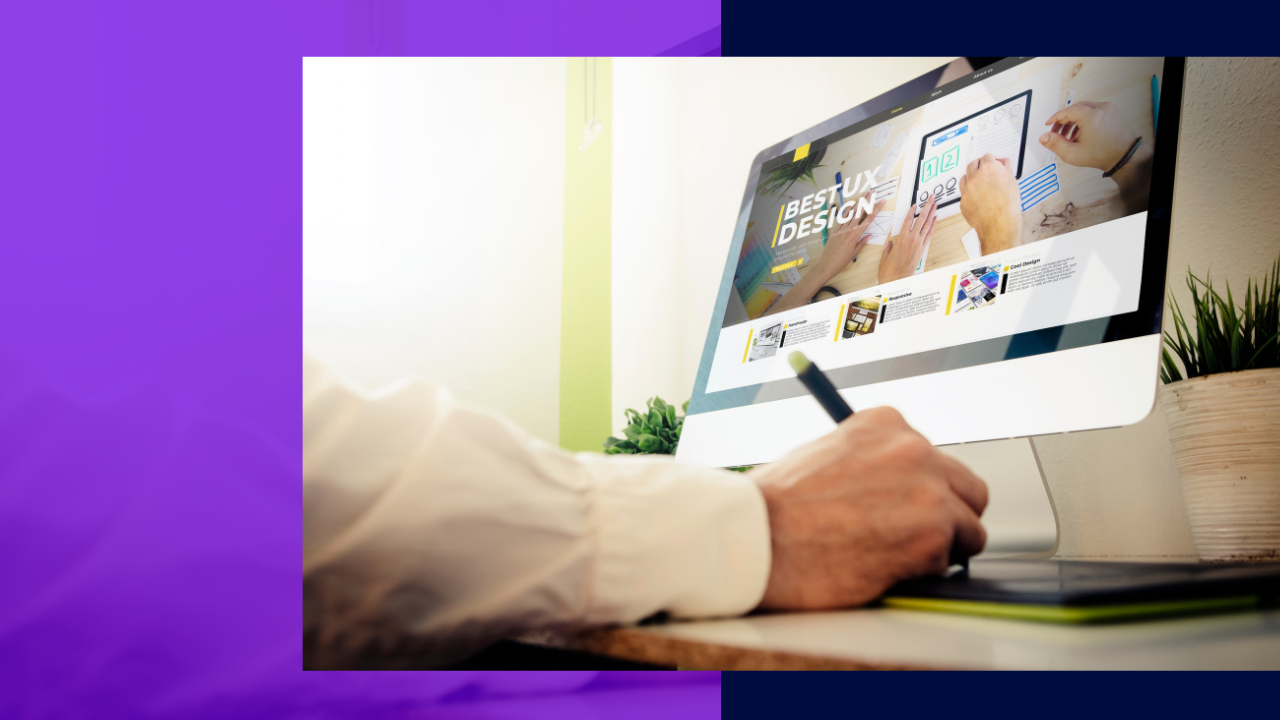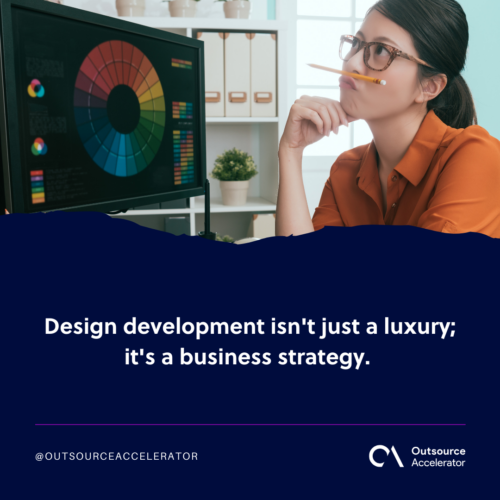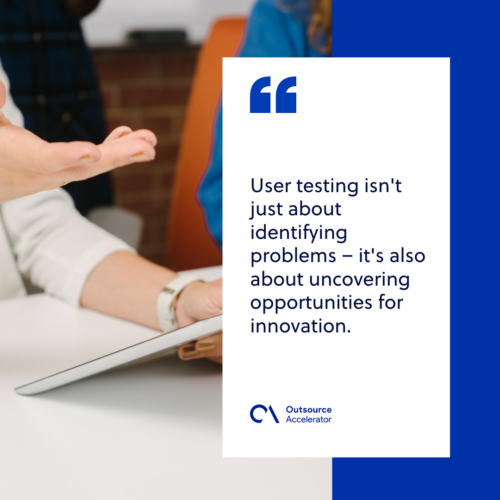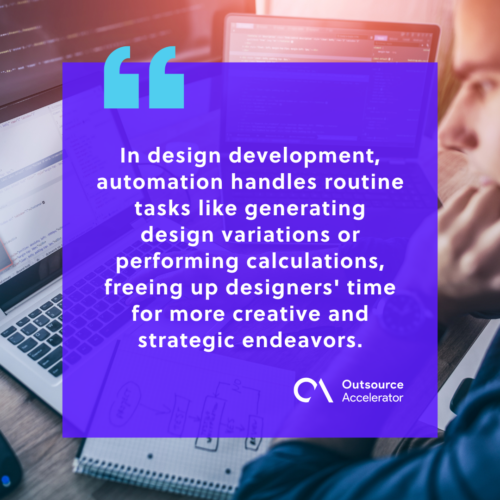Design development: A comprehensive guide for successful projects

Imagine every product you encounter lacks thoughtful design.
Would it captivate your attention? Probably not.
In the world of creation and innovation, design development stands as a cornerstone for successful projects.
Whether it’s the sleek contours of a smartphone or the intuitive layout of a website, design development is the invisible hand guiding us through modern life.
Definition of design development
Design development is the process that transforms abstract ideas into tangible realities. It involves creativity, empathy, and a stronghold of user needs.
Design development isn’t just a luxury; it’s a business strategy.
In a crowded marketplace, exceptional design sets you apart. It communicates professionalism, builds trust, and fosters brand loyalty.

Stages of design development
A design development process usually covers the following phases:
Conceptualization
At the heart of every project lies the conceptualization stage. This is where ideas are born and possibilities are explored.
It’s like the blank canvas for a painter, offering limitless potential. Here, brainstorming sessions, mind mapping, and creative exercises come into play.
Initial design
With the concepts in hand, the initial design phase takes shape. It’s the first step toward turning dreams into reality.
In this stage, designers sketch, draw, or even create basic prototypes to visualize their ideas. The blueprint lays the foundation for the rest of the process.
Design iteration
Design is an iterative process, and this stage emphasizes refinement. It’s about analyzing the initial design, identifying potential improvements, and making necessary adjustments.
Detailed design
Small things count. At this stage, the general ideas become precise details.
Engineers and designers collaborate closely to address technical aspects, ensuring that the design looks good and works seamlessly.
Material and technology selection
The right materials and technologies are the backbone of any successful project. Designers consider factors like durability, cost, and environmental impact.
This phase is similar to picking the best ingredients for a recipe.
Prototyping
Prototyping is the stage where the design takes its first steps toward tangible reality.
During this phase, designers transform their conceptual ideas into physical or digital prototypes that glimpse how the final product will look and function.
User testing
User experience is paramount. During this phase, the design is tested by actual users. Their feedback guides refinements and ensures the end product resonates with its intended audience.
UX/UI design is one of Arcanys’s specialties, ensuring they produce top-notch software.
User testing isn’t just about identifying problems – it’s also about uncovering opportunities for innovation. Designers can discover features or functionalities that users didn’t anticipate but greatly appreciate.
Refinement
Refinement is an important process where designers make changes. Designers carefully consider the feedback gathered during previous stages, making thoughtful adjustments to address shortcomings.
Also, refinement is about analyzing user interactions, understanding pain points, and finding innovative solutions.
Finalization
The third-to-last stage is where the design is completed. All the earlier steps come together smoothly.
Finalization involves meticulously reviewing every design aspect – from the smallest details to the overall user experience.
Designers ensure the design aligns with the project’s goals and meets the intended specifications.
Handoff and implementation
Moving from design to making it happen is very important. Designers hand it over to engineers, and the product becomes real.
Engineers use their expertise to translate the design into functional code, physical prototypes, or tangible products.
Post-implementation review
Even after implementation, the journey isn’t over. Post-implementation reviews help identify successes and areas for improvement.
The insights gathered during the post-implementation review guide future iterations and improvements. If certain design aspects fall short of expectations, designers can make informed decisions to enhance those areas.

Collaborative workflow in design development
Collaborative workflow in design development involves a structured and coordinated process where multiple individuals or teams work together to create, refine, and finalize design concepts.
This approach maximizes creativity, expertise, and efficiency while ensuring the final design meets the desired goals and objectives.
Multidisciplinary teams
Design development thrives on collaboration. Multidisciplinary teams bring together individuals with diverse skills and perspectives.
It’s like assembling a group of experts who each contribute a unique ingredient to a recipe.
Communication and iteration
Effective communication is what keeps everything connected. Regular updates and open discussions create a space for constant improvement.
Designers, engineers, stakeholders, and team members must be on the same page, sharing ideas, feedback, and insights. Regular updates and open discussions foster an environment of collaboration and alignment.
Client and stakeholder involvement
Clients and stakeholders are essential. Their input makes sure the end product matches the planned vision.
Feedback from clients and stakeholders ensures that the design meets functional requirements, captures the essence of the brand, and engages the intended audience.
Addressing challenges in design development
Design development is not without its challenges. To ensure successful project outcomes, being prepared and proactive in addressing these challenges is important.
Budgetary and resource constraints
Facing challenges is certain, and limited budgets can be a big obstacle.
Designers carefully select design elements, technologies, and materials that align with the budget while maintaining the integrity of the design’s vision.
Technical feasibility
Some ideas can’t work in practice. Designers must find the balance between creativity and reality, like creating a dish with distinct flavors while still following the cooking process.
Close collaboration with engineering and technical teams guarantees that the design can be realized within the defined limitations and fulfills all functional prerequisites.
MVP Asia Pacific is among many excellent service providers with good technical experts willing to collaborate with you in this process.
Meeting deadlines
Time matters greatly in design progress. Meeting deadlines needs smart time management and prioritizing.
Consistent progress monitoring and communication aid in detecting potential setbacks ahead of time, enabling prompt adaptations and minimizing disruptions to the project timeline.
The future of design development
Design development is an ever-evolving field, and staying informed about the emerging trends shaping its future is important.
Integration of AI and automation
AI analyzes data and user behavior to predict design trends and user preferences, guiding designers in making informed decisions that connect with the target audience.
In design development, automation handles routine tasks like generating design variations or performing calculations, freeing up designers’ time for more creative and strategic endeavors.
Sustainable and eco-friendly design
With sustainability becoming more important, design advancement will center on eco-friendly solutions.
Integrating sustainable materials and energy-efficient technologies is essential to meet consumers’ evolving expectations and contribute to a greener future.
3D printing and additive manufacturing
3D printing and additive manufacturing are changing design progress significantly. They provide quick prototyping and options for customization.
Designers create 3D models on a computer and use 3D printers to layer materials and build physical prototypes. This process offers rapid prototyping and customization possibilities, enabling designers to iterate and refine their designs quickly and precisely.

Nurturing innovation through thoughtful design development
Design development is not just about creating functional and visually appealing designs; it’s also about fostering innovation.
By adopting an expert but conversational tone and incorporating insights from various disciplines, we can create designs that push boundaries and solve real-world problems.
Through a comprehensive and collaborative approach, design development can drive innovation, enhance user experiences, and shape the future of design.
Firms like MVP Asia Pacfic can help you achieve this, thanks to their expert team of designers and digital marketers.







 Independent
Independent




